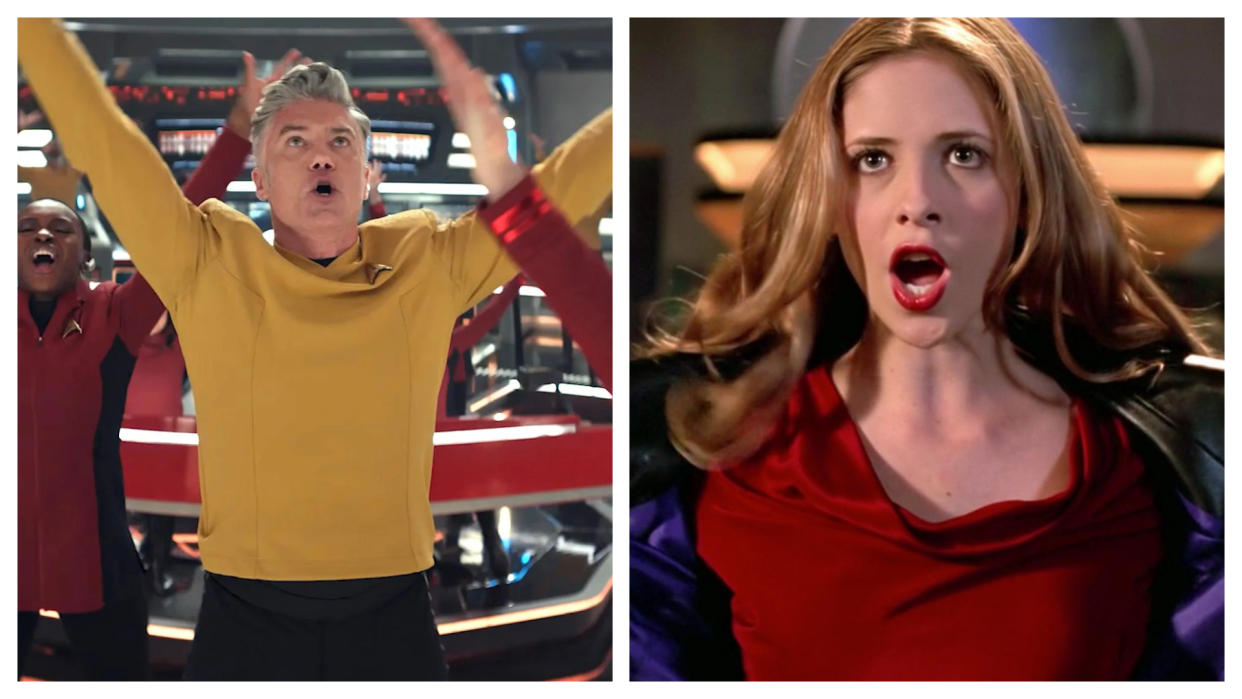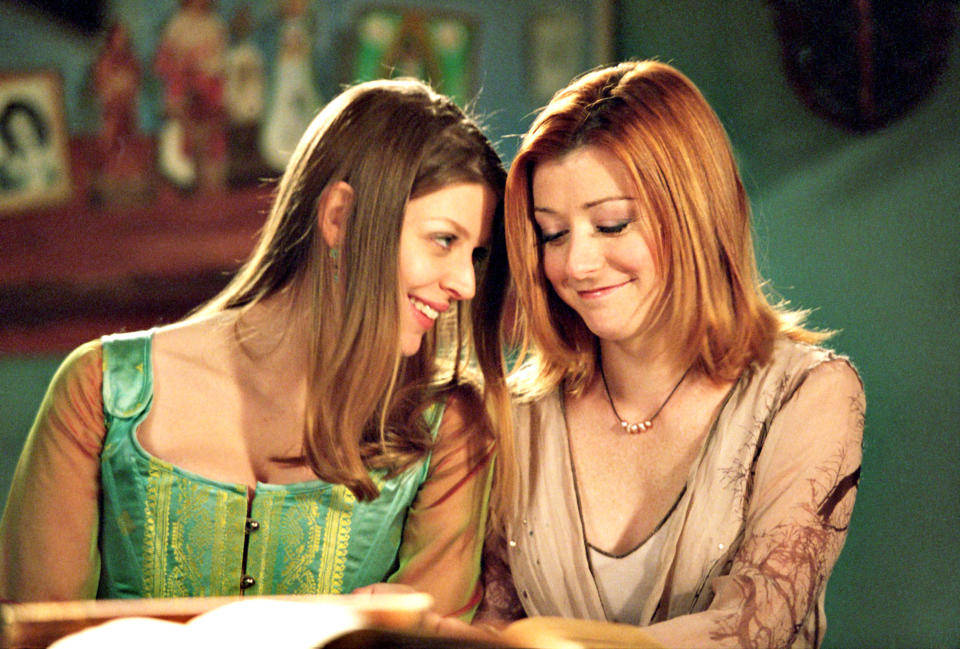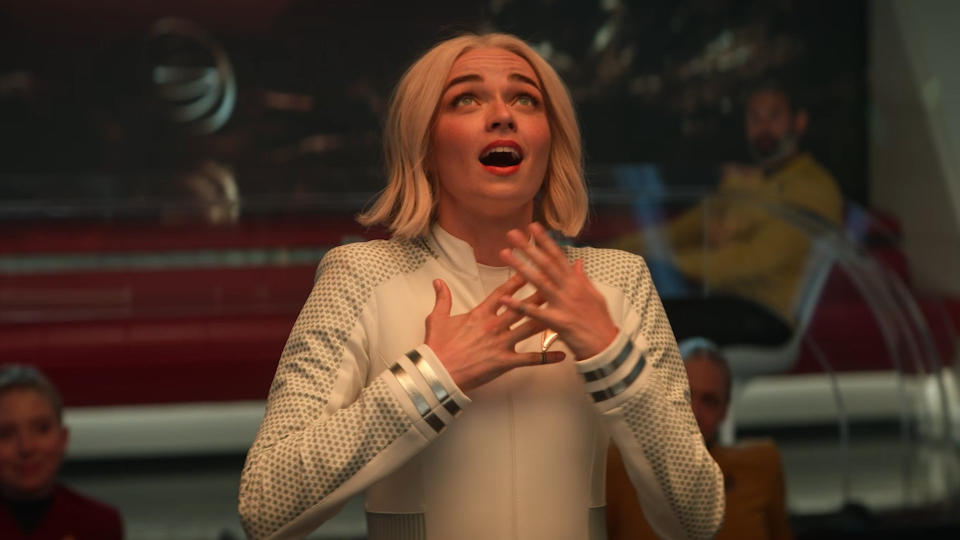‘Star Trek: Strange New Worlds’: ‘Subspace Rhapsody’ Is TV’s Best Musical Episode Since ‘Buffy’

- Oops!Something went wrong.Please try again later.
In “Subspace Rhapsody,” the penultimate episode of “Star Trek: Strange New Worlds” second season, a mishap involving a recording of Cole Porter’s “Anything Goes” and a “subspace fold” causes what the franchise’s technobabble labels an “improbability field:” a glitch in reality that forces the crew of the U.S.S. Enterprise to behave like they’re in a musical, bursting into song at inopportune times. Immediately after the big stage-setting ensemble number, Captain Pike (Anson Mount) holds a meeting to figure out what happened, and security officer La’an (Christina Chong) rolls her eyes and asks “What’s next? More improbability, or will we suddenly just poof into bunnies?”
The joke, in the context of the episode, feels slightly random and out of step with the show’s typical sense of humor. But for anyone who has ever watched “Buffy the Vampire Slayer,” the reference to bunnies instantly brings to mind a specific song from another musical episode, maybe the most famous one in the subgenre — “Bunnies,” Anya’s (Emma Caulfield) rock solo in Season 6’s “Once More With Feeling.”
More from IndieWire
“Once More With Feeling,” which focuses on the cast of the teen fantasy drama fighting a demon that cursed the town of Sunnydale into singing their inner thoughts, wasn’t the first musical-themed episode of TV ever produced; there was a 1997 episode of medical procedural “Chicago Hope” where the cast burst into song as a result of brain aneurysm-induced hallucinations, to name one example. But the “Buffy” episode is notable for the acclaim that it received, becoming a fan favorite in a series that already drew obsessive adoration from its audience. And in the years since its 2001 release, it has seemingly inspired other shows to force their characters to belt their hearts out in (hopefully) epic fashion for an installment or two.
Medical dramas like “Scrubs” and “Grey’s Anatomy” cribbed a little from “Chicago Hope” with episodes where patients hallucinated musical numbers from their doctors. “The Flash” and “Supergirl” crossed over in an episode where Darren Criss’ Musical Meister inspired the heroes to sing the extremely silly song “Super Friend.” “Psych” made a full two hour event out of its seventh season musical episode. Even “It’s Always Sunny in Philadelphia” dipped into the fun, with its well-loved “The Nightman Cometh” episode about the gang putting on an incoherent rock opera.

The appeal of the musical episode, separate from full on musical shows like “Glee,” is obvious; it’s an easy way to make an installment that departs from formula and sticks out as memorable, and the extra level of time and effort involved in bringing one together can be impressive. But in practice, the majority of musical episodes tend to be frustratingly superficial, gimmicky ploys for attention that dilute rather than enhance a show’s narrative; look at the series of “Riverdale” episodes that focus on the cast’s school productions of musicals like “Carrie” or “Hedwig and the Angry Inch” as examples, installments that clumsily graft the shows’ songs onto the characters with little to no regard for how they fit into the storylines of the people singing them. The question that underlines every piece of musical theater is what do the songs and dances achieve that dialogue and blocking cannot; most one-off musical episodes don’t try to bother answering.
So it’s delightful that “Subspace Rhapsody,” which could be a cheesy disaster, ends up one of the most satisfying and fun episodes of “Strange New Worlds” consistently great second season. And while it has surface-level pleasures — songs from Tom Polce and Kay Hanley of the alt rock band Letters to Cleo that adapt the franchise’s terminology to amusing ends, a cast whose musical abilities range from “trying their best” (Mount, mostly speak singing) to legitimately great (Celia Rose Gooding, a Tony nominee for the Alanis Morissette musical “Jagged Little Pill”), rapping Klingons — it primarily succeeds by taking a lesson directly from “Buffy the Vampire Slayer’s” handbook.
In “Once More With Feeling,” the central conceit of the curse that musical demon Sweet (Hinton Battle) places on Sunnydale is that the songs that the citizens are forced to sing reveal their deepest truths. For the Scooby Gang, this means Giles (Anthony Head) and Tara (Amber Benson) both realize they need to abandon the person they love for very different reasons, while Anya and her fiancé Xander (Nicholas Brendon) share their mutual doubts about their impending nuptials. Most prominently, the entrance into a musical reality causes Buffy (Sarah Michelle Gellar) to finally open up about the intense depression she’s been feeling all season, and give herself over to her desire for former enemy Spike (James Marsters).
It’s a story that succeeds because it leans into and comments on what makes musicals special, how the songs act as expressions of happiness, anger, despair, lust, or love too intense to properly be described in words. Future TV shows that feature musical sequences every episode — such as the satirical “Crazy Ex-Girlfriend” or the jukebox “Zoey’s Extraordinary Playlist” — would adopt a similar tactic for how they deployed musical sequences, acting as fantasy windows into the inner lives of characters that don’t communicate their real thoughts with each other.
And “Subspace Rhapsody” almost directly pulls “Once More With Feeling’s” fantasy musical logic into its sci-fi universe. Early on, Gooding’s Uhura, the resident musical theater geek on the ship, explains how the new reality the crew is briefly living in works; they sing when their emotions are their most intense, overriding rational thinking and giving way into a vocalization of their purest id.

The curse of being forced to reveal your innermost secrets through song is a particularly cruel one to put on the cast of “Strange New Worlds.” As a crew of highly decorated officers for Starfleet, the main characters of the show aren’t exactly a cold bunch, but they’re a group whose interactions and relationships are undergirded by the Enterprise chain of command. Many characters, like Rebecca Romijn’s Una Chin-Riley, purposefully keep themselves at a distance from their subordinates due to their own secrets or past traumas. Spock (Ethan Peck), a character synonymous with cold logic over emotional openness, is one of the main faces on the ship.
So under the rules of a musical reality, the formalities inherent to the crew’s positions fall away, and the characters are forced to express what they’re actually thinking. Rather than being the one-off gimmick episode musical experiments tend to be (again, “Once More With Feeling,” which altered the course of its season in several ways, is a major exception), Dana Horgan and Bill Wolkoff’s script for “Subspace Rhaspody” uses its songs to advance almost every major subplot in the show, provoking the buttoned up crew into uncomfortable honesty. Co-showrunner Akiva Goldsman even joked to IndieWire’s Christian Blauvelt that he wished every Episode 9 of a 10-episode season could be a musical episode, for how quickly the format can resolve season-long character arcs — and to emotionally satisfying effect.
Una comes to an emotional realization about the effect hiding her status as an augment has had on her life, Pike admits his doubts and worries about his relationship with girlfriend Batel (Melanie Scrofano), and Uhura is able to express, and heal slightly from, the trauma of her mentor Hemmer’s (Bruce Horak) death in Season 1. The empathetic Nurse Chapel (Jess Bush) vocalizes, through a free-wheeling group number, that she prioritizes her career over her nascent romance with Spock, who in turn sings a response song expressing his humiliation and a resolve to further bury his human side. These are all revelations that theoretically could be done in a non-musical episode, but the beauty of “Subspace Rhapsody” is how the songs so efficiently break down the cast’s emotional barriers, shifting the way they communicate with one another entirely.
The character most affected by the “improbability field” is La’an, who in the season’s third episode “Tomorrow and Tomorrow and Tomorrow,” met and fell in love with an alternate version of original series star James Kirk (played in “Strange New Worlds” by Paul Wesley), thanks to some time travel convolutions. With Kirk aboard the ship for the episode, La’an grows paranoid about revealing her lingering feelings for “her” Kirk to a man she mostly doesn’t know, and from the privacy of her quarters sings a “Let It Go” type ballad about her desires for love and her inability to pursue anything in life without caution.
In the episode’s best scene, La’an decides to come clean about her unusual circumstances to Kirk before the musical logic forces her into it. Kirk is gracious and sympathetic, but awkwardly reveals he’s already in a relationship (with Carol Marcus, who “Star Trek” fans will remember from “The Wrath of Khan”). Chong, very often the show’s MVP, plays her reaction beautifully, with a wistful sadness and longing for what could have been palpable in her every word. You expect her to break out into song at some point, but it never comes. For a very brief moment, La’an doesn’t need music to say what she’s feeling.
“Star Trek: Strange New Worlds” is now streaming on Paramount+. The Season 2 finale premieres August 10.
Best of IndieWire
Sign up for Indiewire's Newsletter. For the latest news, follow us on Facebook, Twitter, and Instagram.

